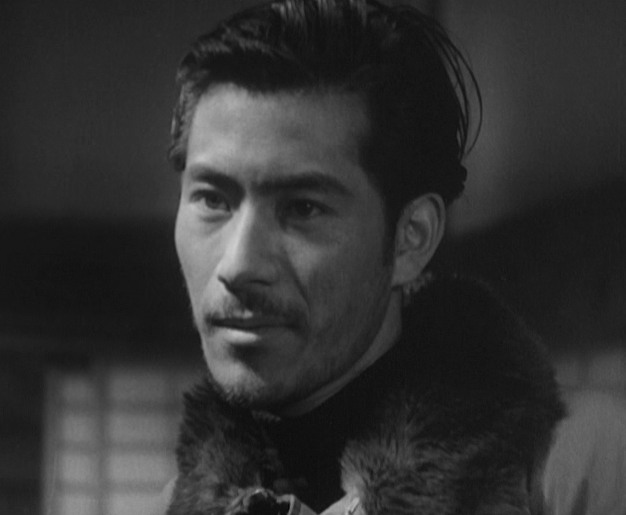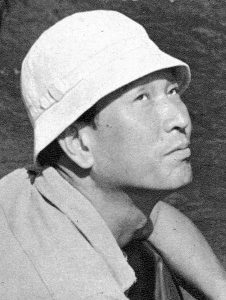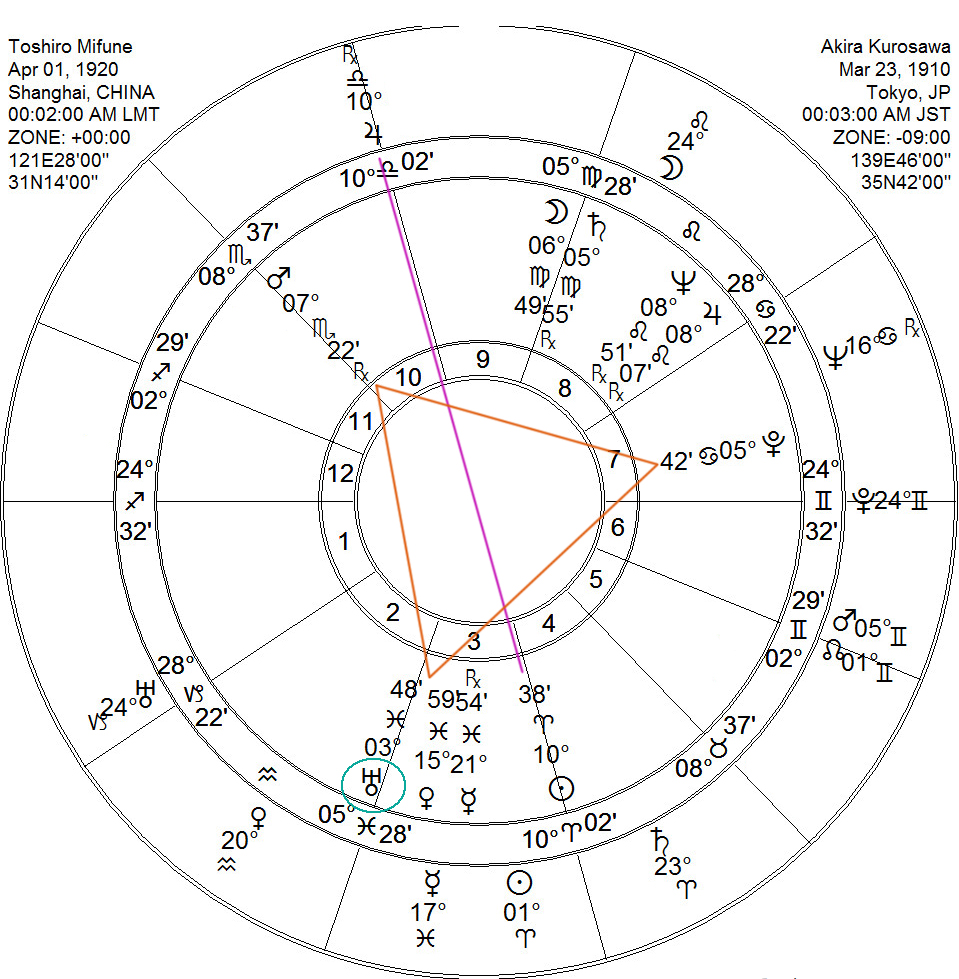 Actor Toshiro Mifune and director Akira Kurosawa had a collaborative destiny in film par excellence. Both were superb in the expression of their individual talents but it is to Toshiro Mifune that we will focus our attention. We’ll look to see what it is in the heavenly bodies that reflect what took place during his career as an actor in Kurosawa’s films.
Actor Toshiro Mifune and director Akira Kurosawa had a collaborative destiny in film par excellence. Both were superb in the expression of their individual talents but it is to Toshiro Mifune that we will focus our attention. We’ll look to see what it is in the heavenly bodies that reflect what took place during his career as an actor in Kurosawa’s films.
Toshiro Mifune was born in China to Japanese parents and followed in the footsteps of his father’s career in the arts, albeit in motion pictures as opposed to still photography. His first presence on film was when he was a baby and his father used him as a subject for an advertisement project. Later, as an adult, Mifune was catapulted into stardom as an actor thanks to his good looks and larger-than-life prowess on the big screen. His dominating presence and acting style have been compared with that of Marlon Brando, and like John Ford who featured John Wayne in many of his films, Kurosawa repeatedly placed Mifune in the leading roles in his.
The world recognition of this Japanese team’s contribution to cinema came about through accolades that were given to western, blockbuster remakes of these Asian prototypes. Kurosawa’s 1954 epic Seven Samurai, starring Toshiro Mifune, was the inspiration for The Magnificent Seven released in 1960, and again in 2016 with yet another all-star cast. George Lucas’ Star Wars, released in 1977, was inspired by Kurosawa’s 1958 forerunner The Hidden Fortress where Mifune became the archetype for Obi-Wan Kenobi. The Japanese team’s 1961 Yojimbo was used as the concept for the 1967 spaghetti western, A Fist Full of Dollars which made Clint Eastwood into an international star, and there are many more remake examples of this creative team’s repertoire too numerous to list here.
Interestingly, Kurosawa considered his precursor John Ford, the famed Hollywood director, to be his idol. He admired and used Ford’s techniques in lighting and cinematography to lay the foundation for his own early films, including the 1950 film Rashomon, which received worldwide acclaim for its camera angles and style. Here again the lead was played by Mifune, who was chosen for the role because his emotional power was riveting which is just what the part required.
Astrological support for Mifune’s impressive character renditions was provided by the energy-charged Pluto, Mars, and Uranus trio of planets that are the components of a coveted Grand Trine in water signs. This Focal Determinator is a configuration that passes one planet’s energy to the others in turn in circular fashion, building character and personality along the way. The circulating energies promote a pyramiding effect that taps the inner talents with which the native was born, for the purpose of furthering its ongoing development. In contrast, opposition aspects facilitate one’s outreach into the objective world. The two very different types of aspects work together to manifest outwardly what the Grand Trine generates from within.

The 120-degree aspect was and still is considered a blessed feature to have in a horoscope, however, the Grand Trine was thought to be a hindrance by ancient astrologers because of its tendency to create habitual grooves of activity whether for good or ill. It also indicates an inclination to pamper or protect oneself within the confines of its own subjective reality and this can often interfere with the native’s ability to take advantage of normal opportunities that oppositions offer. Mifune’s dependence on alcohol was his way of avoiding direct interaction with challenges to his will. However, the Grand Trine still endowed him with the ability to reach a pinnacle of success at least in the world of Japanese cinema and foreign audiences up to the task of tackling subtitles.
If a negative pattern of activity is set in motion by a native and supported by the grooving propensity of a Grand Trine, as with Mifune’s periodic alcoholic binges, there is the possibility to break from this downward spiral through the activation of a planet in square with any of the three planets in the balanced triangle. A planet in a 90-degree aspect to the Grand Trine can disrupt a destructive momentum by creating an inner struggle that allows the native to withdraw, however difficult it may be, from negative habit patterns. The opportunity for such interruptions of conditioning is when there are significant transits or progressions activating the planet in square to the Grand Trine, especially by conjunction or opposition. The withdrawal from the ongoing repetitious act offers a reset in attitude and encourages new and more constructive patterns to be established. Going forward, the Grand Trine will then support a new groove of experience the same as it did for the negative cycle needing to be discarded.
Mifune’s chart configurations show that he has the capacity to break from repetitive, negative behaviors, thanks to the conjunction of Jupiter and Neptune in square with Mars that takes part in the Grand Trine. In the creative sign of Scorpio, Mars bestowed upon the native a magnetic, sexual panache. This made the actor highly desirable to audiences and that resulted in high box office revenue for the filmmakers.
The Jupiter-Neptune exact conjunction is the source of the magnitude of the actor’s big screen presence. Neptune relates to conscious imagery, with movies being the extension and projection of man’s imagination. Jupiter in tight conjunction with Neptune expands the illusory and phantasmal influence of which Neptune is characteristic.
Unique Chart Features
There are five retrograde planets in Mifune’s natal chart that encourage the highly introspective nature of the native and this emphasizes the already internalization of the Grand Trine. The sympathy and compassion for his fellow actors and the tender side he revealed to some are traits related to the three planets in Pisces. Uranus is the Cutting planet of his powerful Locomotive Temperament Type, with the pattern being fairly ideal since the chart includes the desired Grand Trine with a Core Opposition formed by Uranus applying to the moon separating from the aspect. The keyword for Uranus is Independence, However, in High Focus its keyword becomes Experimentative. With a strong sense of freedom to act as he was intuitively inspired, Mifune was given Uranian free rein in the interpretation of the characters he portrayed in Kurosawa’s films. The Locomotive temperament imbues a driving force of personality, and the momentum of the Grand Trine furthers the projection of the native’s personality onto others. Men could easily identify with the forceful, masculinity he projected, and women could melt under his fiery influence.

There is no exact time of birth documented for the actor, so one can only assume several birth hour possibilities. When supposing that Mifune’s birth was in the earliest hours of April 1, 1920, his Sun’s Sabian symbol would be The president of the country. What is fascinating about the description of this symbol is the several references to playing a role among his fellows and the impact that position would have in bringing the native notoriety.
ARIES 11 The president of the country This is a symbol of high ego on the impersonal side, evident in the complete and naïve dedication of the individual to some part he chooses to play among his fellows. Implicit here is the selection of such a role as will have a maximum breadth of recognition, so that the player may be established in a reality which he would be quite unable to sustain by himself. There is a subordination of all other considerations to one primary act of individual assurance. The keyword is IDEALIZATION. When positive, the degree is the self-sacrifice required of anybody who would become the creative representative of eternal value, and when negative, an often well-meaning but usually destructive assertiveness or vain pretense.
As the day progressed, however, the Sun moved to the following degree and image. Had Mifune been born just before noon or thereafter the symbol would have been A flock of wild geese. This symbol’s detailed description could also reflect the native’s actual role in life. However, it is best to avoid giving too much credence to the Sun’s Sabian image until the true time of birth emerges, which in this case is highly improbable. For comparison’s sake, the alternative symbol follows:
ARIES 12 A flock of wild geese This is a symbol of the irresistible aspiration and indomitable desire for freedom which represent the real core of personality, and which in everyday affairs are often the sole manifestation of an individual’s immortal potential. Here there are vagaries of immediate caprice to the point of irresponsibility, but through them is the undeviating course characteristic of the migratory fowl and so a promise of obligations to be met and ideals to be realized. The keyword is INSOUCIANCE. When positive, the degree is a completely naïve independence or an ever-immediate capacity for rising above any given involvement in experience, and when negative, thoughtless disinterest in anything of real value to the self.
The powerful impact on audiences of Mifune’s screen persona is provided by the Locomotive temperament that is buttressed in the chart by the multiple conjunctions of planets around the wheel. Planets that “join forces” through 0 to 10 degrees orb arrangement, amplify their potential to impress their energies onto others. This can be seen by the actor’s influence over the director when having his way continuously in terms of acting style and presentation. Spontaneous contributions were encouraged, and this can be seen astrologically by the exact opposition from the native’s Sun to Kurosawa’s Jupiter. Mifune’s ego complimented the director’s enthusiasm with each offering the other a vehicle of personal self-expression and gratification.
Mifune’s Moon-Saturn conjunction shows he was calculating and possibly passive rather than spontaneous in his acting methods, and he was known for preparing the nuances of his characters’ nature and mannerisms far in advance of his performances. The trine to the Sun from the Jupiter-Neptune conjunction is all the planetary influence he needed for the smooth interpretation of the compelling characters he played.
The Kurosawa-Mifune collaboration consisted of 16 films, with Mifune’s career spanning from 1948 to 1965. In all, the actor appeared in 150 feature films. Although it is hard to think of him appearing in any films as great as those made with Kurosawa, a possible contender might be the 1954 Samurai Trilogy directed by Hiroshi Inagaki in which he portrayed with gusto, the renowned and undefeated swordsman, Miyamoto Musashi.

I find it always amazing how precise you can reveal the innermost Potentials of a person through your ability of expression together with applying the technics of M.E.Jones.
A great pleasure for me to read.